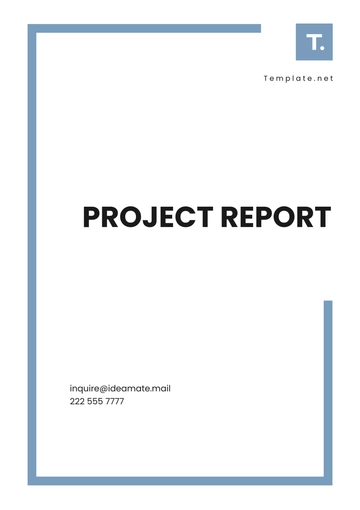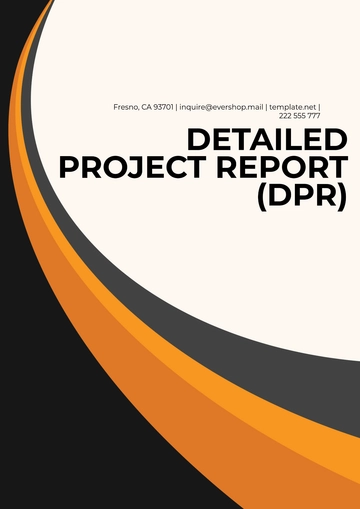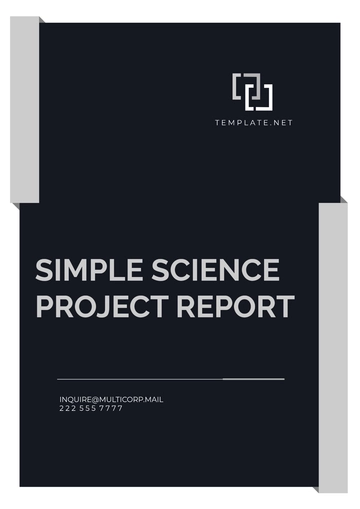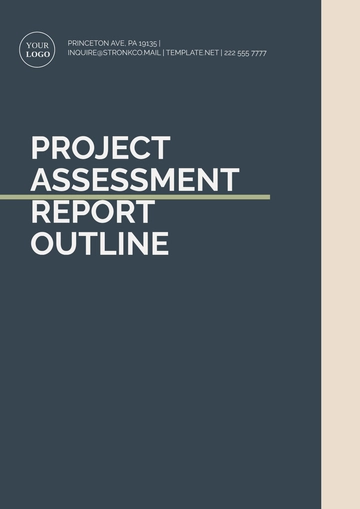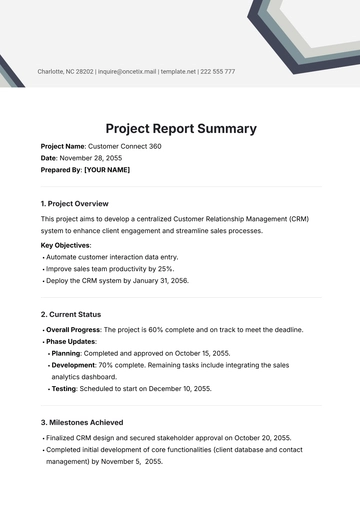Free Business Retention Project Report

Report Prepared By: [Your Name]
Contact Email: [Your Email]
Company: [Your Company Name]
Company Email: [Your Company Email]
I. Executive Summary
The Business Retention Project aimed to identify businesses facing closure risks, develop tailored strategies for their retention, implement support measures, and assess the effectiveness of these efforts. This report outlines the project's key objectives, methodologies, findings, and recommendations.
II. Project Overview
A. Project Objectives
Identify At-Risk Businesses: Utilize financial, market, and operational criteria to pinpoint businesses susceptible to closure.
Develop Retention Strategies: Tailor strategies including financial assistance, marketing initiatives, and operational improvements.
Implement Support Measures: Execute the devised strategies with clear timelines, responsibilities, and budget allocations.
Assess Effectiveness: Evaluate the impact of retention efforts on business continuity, financial stability, and employee retention.
B. Project Scope
Targeted Industries: Manufacturing, Retail, and Hospitality sectors.
Geographic Focus: City A, City B, and surrounding areas.
Timeframe: January 2050 to December 2050.
C. Project Team
Project Manager: Sarah Johnson
Team Members: John Smith (Financial Analyst), Emily White (Marketing Specialist), David Brown (Operations Consultant)
III. Business Assessment
A. Criteria for Identifying At-Risk Businesses
Financial Performance: Declining revenue, cash flow issues, and profitability trends.
Market Conditions: Competitive pressures, changing consumer preferences, and industry disruptions.
Operational Challenges: Inefficiencies, supply chain disruptions, and workforce issues.
Regulatory Environment: Compliance challenges and regulatory changes impacting business operations.
Industry Trends: Technological advancements, market saturation, and emerging threats.
B. Business Evaluation Process
Data Collection: Financial statements, market research reports, operational metrics, and regulatory updates.
Analysis Techniques: Financial ratio analysis, SWOT analysis, and trend analysis.
Risk Scoring Criteria: Weighted scoring model based on the severity of risks in each criterion.
C. Identified At-Risk Businesses
XYZ Manufacturing: Declining profits due to increased material costs and supply chain disruptions.
ABC Retail: Facing competition from online retailers and struggling with outdated marketing strategies.
DEF Hospitality: Decreased foot traffic and revenue loss due to pandemic restrictions.
IV. Retention Strategies
A. Strategy Development
Stakeholder Consultation: Engaged with business owners, industry associations, and government agencies to understand challenges and opportunities.
Market Research: Analyzed consumer trends, competitive landscape, and economic forecasts.
Best Practice Analysis: Studied successful retention strategies implemented in similar industries and regions.
Customized Solutions: Developed tailored solutions addressing the specific needs of each at-risk business.
B. Key Strategies
Financial Assistance Programs: Low-interest loans, grant programs, and tax incentives.
Marketing and Promotion Initiatives: Digital marketing campaigns, loyalty programs, and partnership opportunities.
Operational Efficiency Improvements: Process optimization, inventory management solutions, and cost-saving measures.
Regulatory Compliance Support: Workshops, consulting services, and regulatory updates.
Training and Skill Development: Employee training programs, certifications, and skills workshops.
C. Implementation Plan
Timeline: Financial assistance programs (Q1-Q2), marketing initiatives (Q2-Q3), operational improvements (Q3-Q4).
Responsible Parties: Project Manager (Overall coordination), Financial Analyst (Financial assistance programs), Marketing Specialist (Marketing initiatives), Operations Consultant (Operational improvements).
Budget Allocation: $500,000 allocated for financial assistance, $200,000 for marketing initiatives, $300,000 for operational improvements.
V. Outcome Assessment
A. Performance Metrics
Business Retention Rate: Percentage of at-risk businesses retained after implementing strategies.
Financial Stability Indicators: Profit margins, cash flow, and return on investment.
Employee Retention Rates: Percentage of employees retained during the project period.
Customer Satisfaction Levels: Surveys and feedback from customers of retained businesses.
B. Evaluation Methodology
Surveys and Interviews: Gather feedback from business owners, employees, and customers.
Financial Analysis: Compare financial performance before and after implementation of retention strategies.
Comparative Studies: Benchmark against industry standards and competitor performance.
C. Results Analysis
Implemented strategies resulted in:
XYZ Manufacturing: Improved cash flow by 20% and implemented cost-saving measures, leading to profitability.
ABC Retail: Increased customer engagement by 30% through digital marketing campaigns, resulting in revenue growth.
DEF Hospitality: Diversified revenue streams and adapted to changing market conditions, maintaining business viability.
VI. Recommendations
A. Short-Term Recommendations
Enhance Financial Support Programs: Increase funding for grant programs and expedite loan approvals.
Expand Marketing Efforts: Continue digital marketing campaigns and explore new customer acquisition strategies.
Provide Targeted Training Sessions: Offer specialized training in digital skills and business management.
B. Long-Term Recommendations
Develop Industry-Specific Resilience Plans: Collaborate with industry associations to develop long-term strategies for industry resilience.
Foster Collaboration Among Stakeholders: Establish a business support network involving government agencies, financial institutions, and industry partners.
Implement Ongoing Monitoring and Support Mechanisms: Regularly monitor business performance and provide ongoing support through workshops and advisory services.
VII. Conclusion
The Business Retention Project successfully identified at-risk businesses, developed tailored strategies, and implemented support measures resulting in improved business continuity, financial stability, and employee retention. Continued collaboration among stakeholders and ongoing support mechanisms are recommended to ensure long-term business resilience and growth.
- 100% Customizable, free editor
- Access 1 Million+ Templates, photo’s & graphics
- Download or share as a template
- Click and replace photos, graphics, text, backgrounds
- Resize, crop, AI write & more
- Access advanced editor
Track your business retention efforts with Template.net's Business Retention Project Report Template. This editable and customizable tool helps you document strategies, results, and improvements. Create detailed reports that reflect your retention project’s success. Editable in our AI Editor Tool, this template ensures comprehensive and accurate reporting, aiding in strategic planning and stakeholder communication.
You may also like
- Sales Report
- Daily Report
- Project Report
- Business Report
- Weekly Report
- Incident Report
- Annual Report
- Report Layout
- Report Design
- Progress Report
- Marketing Report
- Company Report
- Monthly Report
- Audit Report
- Status Report
- School Report
- Reports Hr
- Management Report
- Project Status Report
- Handover Report
- Health And Safety Report
- Restaurant Report
- Construction Report
- Research Report
- Evaluation Report
- Investigation Report
- Employee Report
- Advertising Report
- Weekly Status Report
- Project Management Report
- Finance Report
- Service Report
- Technical Report
- Meeting Report
- Quarterly Report
- Inspection Report
- Medical Report
- Test Report
- Summary Report
- Inventory Report
- Valuation Report
- Operations Report
- Payroll Report
- Training Report
- Job Report
- Case Report
- Performance Report
- Board Report
- Internal Audit Report
- Student Report
- Monthly Management Report
- Small Business Report
- Accident Report
- Call Center Report
- Activity Report
- IT and Software Report
- Internship Report
- Visit Report
- Product Report
- Book Report
- Property Report
- Recruitment Report
- University Report
- Event Report
- SEO Report
- Conference Report
- Narrative Report
- Nursing Home Report
- Preschool Report
- Call Report
- Customer Report
- Employee Incident Report
- Accomplishment Report
- Social Media Report
- Work From Home Report
- Security Report
- Damage Report
- Quality Report
- Internal Report
- Nurse Report
- Real Estate Report
- Hotel Report
- Equipment Report
- Credit Report
- Field Report
- Non Profit Report
- Maintenance Report
- News Report
- Survey Report
- Executive Report
- Law Firm Report
- Advertising Agency Report
- Interior Design Report
- Travel Agency Report
- Stock Report
- Salon Report
- Bug Report
- Workplace Report
- Action Report
- Investor Report
- Cleaning Services Report
- Consulting Report
- Freelancer Report
- Site Visit Report
- Trip Report
- Classroom Observation Report
- Vehicle Report
- Final Report
- Software Report
